We have discovered over 5,000 planets around other star systems. Amongst the veritable cosmic menagerie of exoplanets, it seems there is a real shortage of Neptune-sized planets close to their star. A new paper just published discusses a Saturn-sized planet close to its host star which should be experiencing mass loss, but isn’t. Studying this world offers a new insight into exoplanet formation across the Universe.
Continue reading “Saturn-Sized Exoplanet Isn’t Losing Mass Quickly Enough”The Discovery of a Hot Neptune that Shouldn’t Exist

1800 light-years away, an unlikely survivor orbits an aged star. This rare planet is called a hot Neptune, and it’s one of only a small handful of hot Neptunes astronomers have found. Hot Neptunes are so close to their stars that the overpowering stellar radiation should’ve stripped away their atmospheres, leaving only a planetary core behind.
But this planet held onto its atmosphere somehow.
Continue reading “The Discovery of a Hot Neptune that Shouldn’t Exist”What Did The Solar System Look Like Before All The Planets Migrated?
Early planetary migration in the solar system has been long established, and there are myriad theories that have been put forward to explain where the planets were coming from. Theories such as the Grand Tack Hypothesis an the Nice Model show how important that migration is to the current state of our solar system. Now, a team from Lawrence Livermore National Laboratory (LLNL) has come up with a novel way of trying to understand planetary migration patterns: by looking at meteorite compositions.
Continue reading “What Did The Solar System Look Like Before All The Planets Migrated?”Do Hot Jupiters Form Close in, or Do They Migrate? A Newly-Discovered Planet Might Help Answer This
The discovery of over 4000 planets (4,171 confirmed and counting!) beyond our Solar System has revolutionized the field of astronomy. Unfortunately, one of the downsides of all these discoveries is how it has shaken up theories about how our Solar System formed. In the past, astronomers thought that the eight planets (or nine, or over one hundred, depending on your point of view) formed where they are currently located.
However, the discovery of gas giants that orbit close to their stars (aka. “Hot Jupiters”) has confounded this thinking. But according to a recent NASA-supported study, the recent discovery of a young gas giant could offer clues as to how Jupiter-like planets form and whether or not they migrate. This discovery was made possible thanks to the Spitzer Space Telescope, which continues to reveal things about our Universe even in retirement.
Continue reading “Do Hot Jupiters Form Close in, or Do They Migrate? A Newly-Discovered Planet Might Help Answer This”Maybe the Elusive Planet 9 Doesn’t Exist After All

Oh Planet Nine, when will you stop toying with us?
Whether you call it Planet Nine, Planet X, the Perturber, Jehoshaphat, “Phattie,” or any of the other proposed names—either serious or flippant—this scientific back and forth over its existence is getting exhausting.
Is this what it was like when they were arguing whether Earth is flat or round?
Continue reading “Maybe the Elusive Planet 9 Doesn’t Exist After All”‘Nomad’ Planets Could Outnumber Stars 100,000 to 1

[/caption]
Could the number of wandering planets in our galaxy – planets not orbiting a sun — be more than the amount of stars in the Milky Way? Free-floating planets have been predicted to exist for quite some time and just last year, in May 2011, several orphan worlds were finally detected. But now, the latest research concludes there could be 100,000 times more free-floating planets in the Milky Way than stars. Even though the author of the study, Louis Strigari from the Kavli Institute for Particle Astrophysics and Cosmology (KIPAC), called the amount “an astronomical number,” he said the math is sound.
“Even though this is a large number, it is actually consistent with the amount of mass and heavy elements in our galaxy,” Strigari told Universe Today. “So even though it sounds like a big number, it puts into perspective that there could be a lot more planets and other ‘junk’ out in our galaxy than we know of at this stage.”
And by the way, these latest findings certainly do not lend any credence to the theory of a wandering planet named Nibiru.
Several studies have suggested that our galaxy could perhaps be swarming with billions of these wandering “nomad” planets, and the research that actually found a dozen or so of these objects in 2011 used microlensing to identify Jupiter-sized orphan worlds between 10,000 and 20,000 light-years away. That research concluded that based on the number of planets identified and the area studied, they estimated that there could literally be hundreds of billions of these lone planets roaming our galaxy….literally twice as many planets as there are stars.
But the new study from Kavli estimates that lost, homeless worlds may be up to 50,000 times more common than that.
Using mathematical extrapolations and relying on theoretical variables, Strigari and his team took into account the known gravitational pull of the Milky Way galaxy, the amount of matter available to make such objects and how that matter might be distributed into objects ranging from the size of Pluto to larger than Jupiter.
“What we did was we put together the observations of what the galaxy is made of, what kind of elements it has, as well as how much mass there could possibly be that has been deduced from the gravitational pull from the stars we observed,” Stigari said via phone. “There are a couple of general bounds we used: you can’t have more nomads in the galaxy than the matter we observe, as well as you probably can’t have more than the amount of so called heavy elements than we observe in the galaxy (anything greater that helium on the periodic table).”
But any study of this type is limited by the lack of understanding of planetary formation.
“We don’t at this stage have a good theory that tells us how planets form,” Strigari said, “so it is difficult to predict from a straight theoretical model how many of these objects might be wandering around the galaxy.”
Strigari said their approach was largely empirical. “We asked how many could there possibly be, consistent with the broad constraints, that gives us a limit to how many these objects could possibly exist.”
So, in absence of any theory that really predicts how many of these things should exist, the estimate of 100,000 times the amount of stars in the Milky Way is an upper limit.
“A lot of times in science and astronomy, in order to learn what the galaxy and universe is made of, we first have to ask questions, what is it not made of, and so you start from an upper bound of how many of these planets there could be,”Strigari said. “Maybe when our data gets better we will start reducing this limit and then we can start learning from empirical observations and start having more constrained observations that go into your theoretical models.”
In other words, Strigari said, it doesn’t mean this is the final answer, but this is the state of our knowledge right now. “It kind of quantifies our ignorance, you could say,” he said.
A good count, especially of the smaller objects, will have to wait for the next generation of big survey telescopes, especially the space-based Wide-Field Infrared Survey Telescope and the ground-based Large Synoptic Survey Telescope, both set to begin operation in the early 2020s.
So, where did all these potential free range planets come from? One option is that they formed like stars, directly from the collapse of interstellar gas clouds. According to Strigari some were probably ejected from solar systems. Some research has indicated that ejected planets could be rather common, as planets tend to migrate over time towards the star, and as they plow through the material left over from the solar system’s formation, any other planet between them and their star will be affected. Phil Plait explained it as, “some will shift orbit, dropping toward the star themselves, others will get flung into wide orbits, and others still will be tossed out of the system entirely.”
Don’t worry – our own solar system is stable now, but it could have happened in the past, and some research has suggested we originally started out with more planets in our solar system, but some may have been ejected.
Of course, when discussing planets, the first thing to pop into many people’s minds is if a wandering planet could be habitable.
“If any of these nomad planets are big enough to have a thick atmosphere, they could have trapped enough heat for bacterial life to exist,” Strigari said. Although nomad planets don’t bask in the warmth of a star, they may generate heat through internal radioactive decay and tectonic activity.
As far as a Nibiru-type wandering world in our solar system right now the answer is no. There is no evidence or scientific basis whatsoever for such a planet. If it was out there and heading towards Earth for a December 21, 2012 meetup, we would have seen it or its effects by now.
Sources: Stanford University, conversation with Louis Strigari
Astronomy Without A Telescope – The Nice Way To Build A Solar System
When considering how the solar system formed, there are a number of problems with the idea of planets just blobbing together out of a rotating accretion disk. The Nice model (and OK, it’s pronounced ‘niece’ – as in the French city) offers a better solution.
In the traditional Kant/Laplace solar nebula model you have a rotating protoplanetary disk within which loosely associated objects build up into planetesimals, which then become gravitationally powerful centres of mass capable of clearing their orbit and voila planet!
It’s generally agreed now that this just can’t work since a growing planetesimal, in the process of constantly interacting with protoplanetary disk material, will have its orbit progressively decayed so that it will spiral inwards, potentially crashing into the Sun unless it can clear an orbit before it has lost too much angular momentum.
The Nice solution is to accept that most planets probably did form in different regions to where they orbit now. It’s likely that the current rocky planets of our solar system formed somewhat further out and have moved inwards due to interactions with protoplanetary disk material in the very early stages of the solar system’s formation.
It is likely that within 100 million years of the Sun’s ignition, a large number of rocky protoplanets, in eccentric and chaotic orbits, engaged in collisions – followed by the inward migration of the last four planets left standing as they lost angular momentum to the persisting gas and dust of the inner disk. This last phase may have stabilised them into the almost circular, and only marginally eccentric, orbits we see today.

Meanwhile, the gas giants were forming out beyond the ‘frost line’ where it was cool enough for ices to form. Since water, methane and CO2 were a lot more abundant than iron, nickel or silicon – icy planetary cores grew fast and grew big, reaching a scale where their gravity was powerful enough to hold onto the hydrogen and helium that was also present in abundance in the protoplanetary disk. This allowed these planets to grow to an enormous size.
Jupiter probably began forming within only 3 million years of solar ignition, rapidly clearing its orbit, which stopped it from migrating further inward. Saturn’s ice core grabbed whatever gases Jupiter didn’t – and Uranus and Neptune soaked up the dregs. Uranus and Neptune are thought to have formed much closer to the Sun than they are now – and in reverse order, with Neptune closer in than Uranus.
And then, around 500 million years after solar ignition, something remarkable happened. Jupiter and Saturn settled into a 2:1 orbital resonance – meaning that they lined up at the same points twice for every orbit of Saturn. This created a gravitational pulse that kicked Neptune out past Uranus, so that it ploughed in to what was then a closer and denser Kuiper Belt.
The result was a chaotic flurry of Kuiper Belt Objects, many being either flung outwards towards the Oort cloud or flung inwards towards the inner solar system. These, along with a rain of asteroids from a gravitationally disrupted asteroid belt, delivered the Late Heavy Bombardment which pummelled the inner solar system for several hundred million years – the devastation of which is still apparent on the surfaces of the Moon and Mercury today.
Then, as the dust finally settled around 3.8 billion years ago and as a new day dawned on the third rock from the Sun – voila life!




